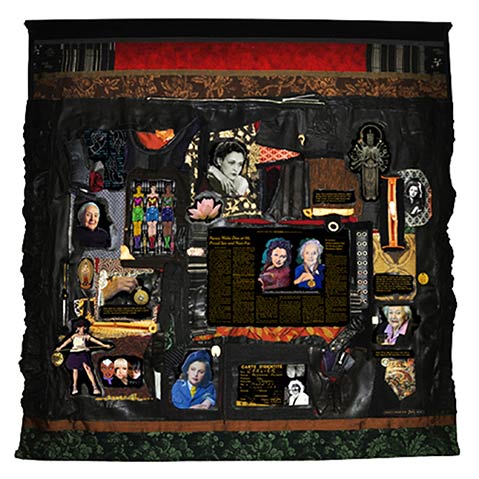‘Holocaust Heroes: Fierce Females’
Artist Linda Stein Depicts Women as Protectors

Tribeca artist Linda Stein creates big, heroic tapestries made of scavenged black leather, elaborate brass buckles, historic artifacts, news articles etched into fabric, and metallic zippers that rip across her work like sewn-up wounds. It’s easy to be overwhelmed by the dark, discarded, and resurrected materials, but there’s a more powerful component woven into these canvases: the transformational element of story. Holocaust Heroes: Fierce Females is the name of Stein’s exhibit of tapestries and sculptures showing at the Bronfman Family Jewish Community Center until March 29. The exhibition is cosponsored by the Morris Squire Foundation, where Stein is an artist in residence, and the Congregation B’nai B’rith’s Toby Parisse Fund and is accompanied by a series of lectures that Stein will be giving over the course of the month.
Unheralded tales of women who crossed typical gender roles and triumphed over adversity continue to come to light. The stories of these “fierce females” that run like a river through these tapestries tear and pull at the viewer every bit as much as the inky-black leather materials that tightly stretch across these works like a second tougher skin.
The first tapestry Stein completed in the series is in some ways the most stunning. It depicts the life of Nancy Wake, a raven-haired beauty who was born in New Zealand and worked with the French Resistance during WWII, parachuting into France to collect night drops of weapons and ammunition for the advancing Allied Armies. The Germans code-named her “The White Mouse.” Once she was forced to kill a German sentry with her bare hands to avoid detection. “I was not a very nice person,” she admitted, “but it didn’t put me off my breakfast.” She lived to the ripe age of 98.
The five-by-five-foot tapestry contains rivets and grommets, faded photos of Wake in her black-haired youth and white-haired old age, her passport and other personal artifacts, and engraved pieces of metal sewn into the patchworked pitch-black leather. Pop icons such as Storm from the X-Men, Hayao Miyazaki’s Princess Mononoke, and the East Asian spiritual figure Guanyin share the assemblage, as well as a series of multiracial Wonder Woman figures reworked from the early rendition of the ’40s.
Stein has updated the original Wonder Woman with her weaponized tiara and lasso of truth to incorporate messages of protection and bravery. “Bravery is not the lack of fear, it’s the proceeding in spite of it,” Wonder Woman’s dialogue bubble reads in one tapestry. Of the 10 women depicted in this exhibit, half are Christian, one is Muslim, and the rest are Jews, all of them feminine but not to be trifled with. All of them are protectors. “They’re not bystanders,” Stein said. “They’re upstanders, and they existed and thrived in Kafkaesque circumstances.”
Women are frequently depicted as protectors but traditionally along motherly lines. The women Stein has chosen existed unequivocally to defend, to fiercely safeguard, and to fight perceived evil. The prosody of these assemblages, with their disfigured gashes of fabric, purse straps, and other materials, wedded to the story of these singular women, resurrects and transcends our understanding of what it means to be brave.
4·1·1
Linda Stein’s work shows until March 29 at the Bronfman Family Jewish Community Center (524 Chapala St.). Stein will also be giving an evening lecture based on her show on Thursday, March 17, at 7 p.m. For more information, call (805) 957-1115 or see jewishsantabarbara.org.



